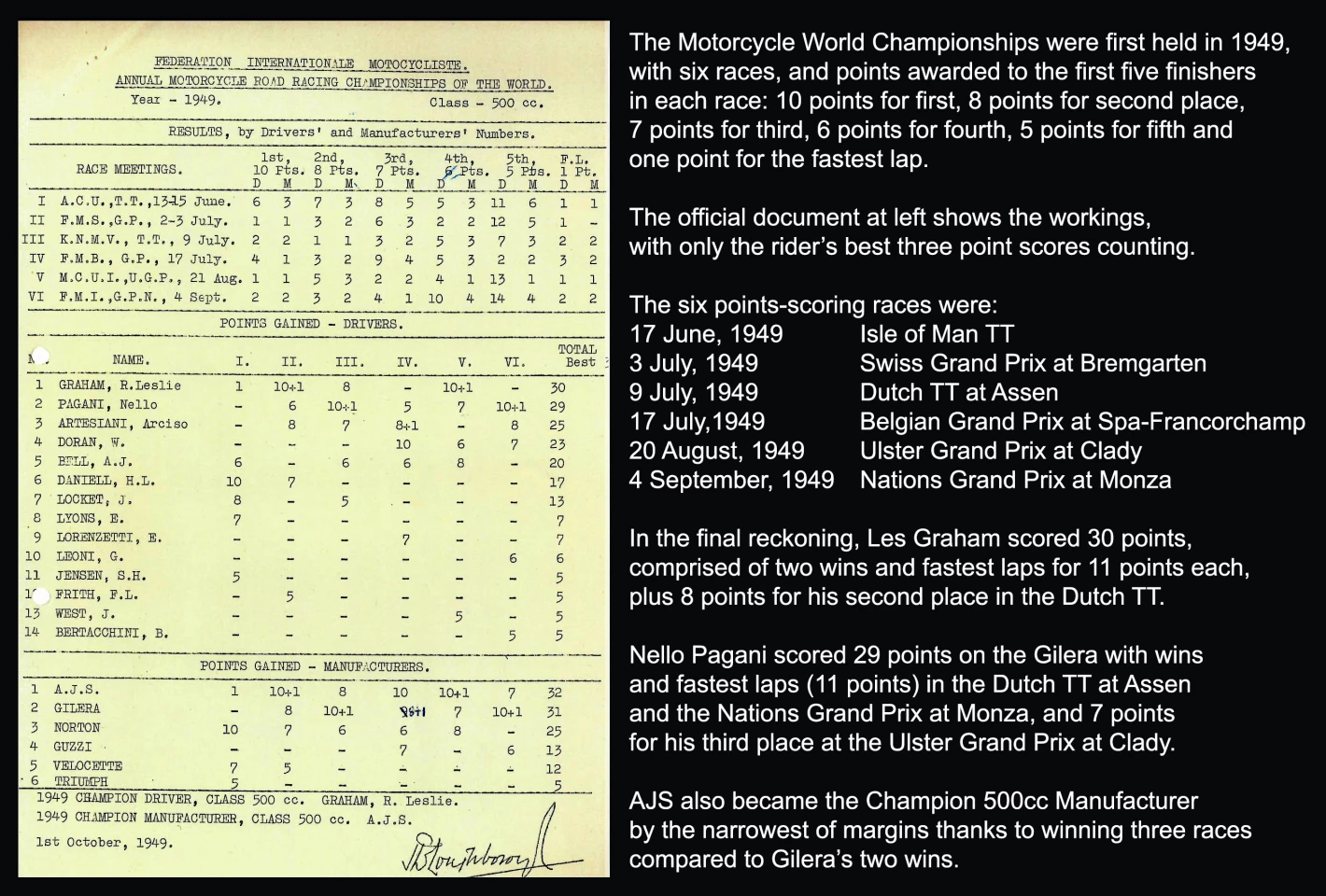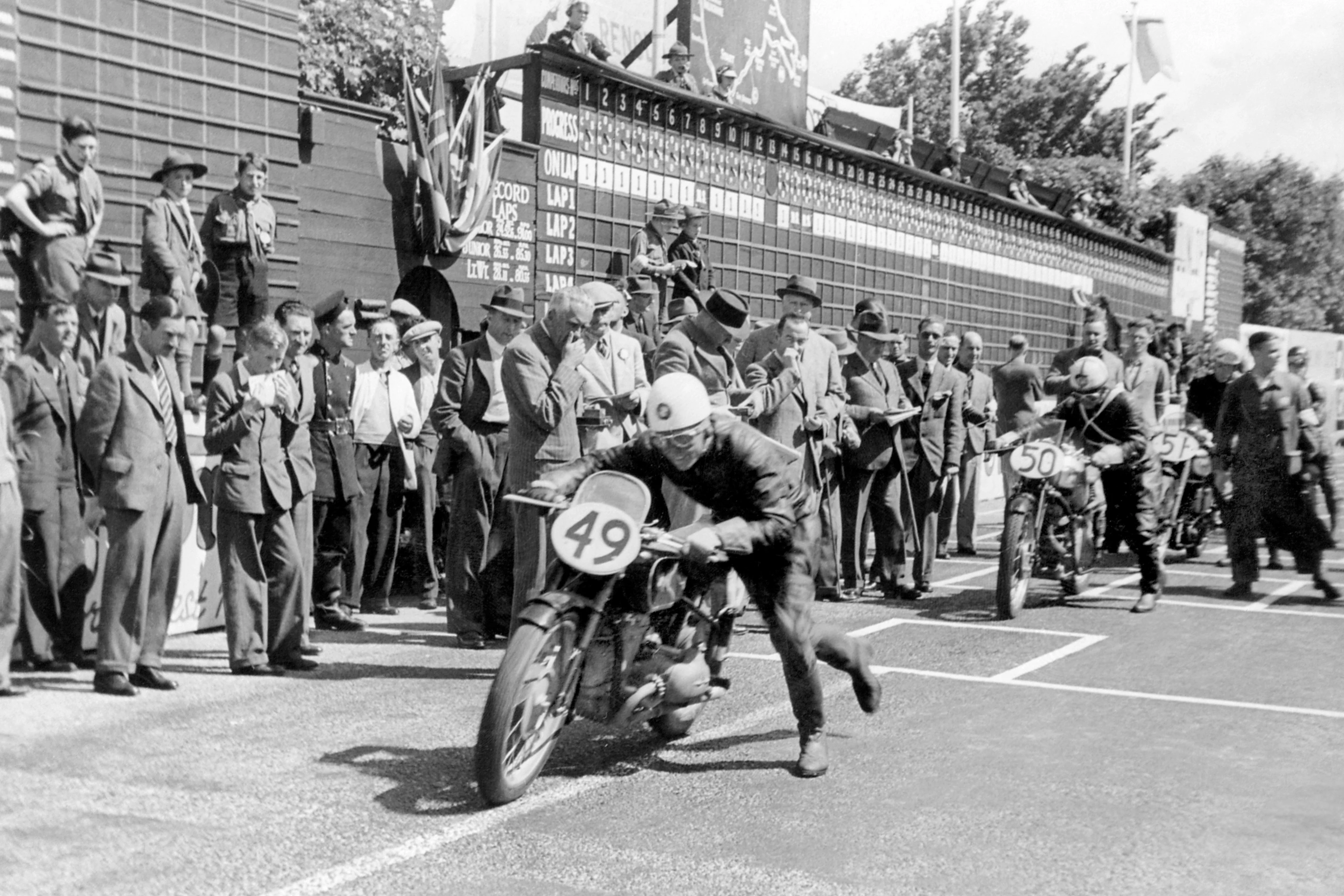Everyone has heard of the AJS Porcupine – it’s the almost mythical world-beating British motorcycle that won the very first 500cc World Roadracing (now MotoGP) Championship in 1949. What you may not realize is that only four of the championship-winning E90 Porcupines were built, (in 1952 another four E95s were built that go by the same "Porcupine" nickname but did not have the distinctive Porcupine fins, and only won one race between them), only two of the championship-winning originals are extant, and one of them is going to auction this week. Once more the world record price for a motorcycle at auction is within reach, and the first million dollar motorcycle is a distinct possibility.
There has never been an AJS E90 go to auction prior to Bonhams' three day Summer Sale later this week, but the Porcupine name is so revered that the first time an E95 went to auction in Bonhams' Spring Staffordshire sale in April 2000, it sold for £163,600 (US$260,386) to become the most expensive motorcycle in the world, leapfrogging all the Brough Superiors, Vincents, Crockers and MV Agusta racers sold before it.
The second time one of the very pretty AJS E95 Porcupines went to auction was at Bonhams in 2011, when it was estimated to sell for between US$750,000 and US$950,000, but failed to meet reserve and the media turned its attention elsewhere.
What isn't common knowledge, is that the E95 was sold post-auction for $675,000 plus fees. As often happens at elite auctions, the buyer isn't keen to generate publicity, and Bonhams agreed not to announce the price. Since then, the leaked price has been posted online and the buyer's premium calculations can be approximated from Bonhams' terms and conditions (12% on the first $250,000 of the bid price and 10% on any amount of the bid price exceeding $250,000), putting the price of the E95 at $747,000.

Had that price been fetched an hour earlier than it was (i.e. at auction), the E95 would have become the world's most expensive motorcycle sold at auction for the second time, despite achieving only one win and two second places in two seasons of Grand Prix racing. Such is the star power of the E90 Porcupine that the subsequent E95 model has twice sold for record amounts. This week's auction is hence a significant event.

Even though that price was achieved more than a decade ago, only four motorcycles have sold at auction for more than that since: Elvis Presley's 1976 Harley-Davidson FLH 1200 Electra Glide ($960,000 including buyers premium) in 2019, Jack Ehret's Australian Land Speed Record Vincent Series-C Black Lightning ($929,000) in 2018, Steve McQueen's 1915 Cyclone Board Track Racer ($852,500) in 2015 and an unrestored 1936 Crocker Small Tank in 2019, one of the original batch of 14 CrockerV-twins ($825,000).
Sadly, the provenance of this E90 going to auction is unknown as the race department records of AJS have not survived. Given that only four E90s were made it is very likely that it played a meaningful role in winning that prestigious inaugural rider's and manufacturer's title, but the accolades cannot be specifically attributed.

Given it came from the collection of former AJS factory rider Ted Frend, it is likely that it is the bike Frend rode to third place in the 1950 Belgian Grand Prix at Spa-Francorchamps on 2 July 1950, but even that is uncertain. Given that Frend didn't join AJS until 1950, the bike may well have played an important role in the inaugural 500cc World Championship of 1949 – the forerunner of what we now know as MotoGP. Perhaps some latter-day detective work might yield more information and make this bike even more valuable.
Just four E90 bikes were built circa 1947 and contested the 1949, 1950 and 1951 World Championships, winning the 1949 Ulster Grand Prix, 1949 Belgian Grand Prix, the 1949 Swiss Grand Prix and 1950 Swiss Grand Prix between them.
The model was responsible for Les Graham winning the 1949 World 500cc Roadracing Championship and the 1949 Manufacturers Championship for AJS. In subsequent years, the E90 finished third (Les Graham) and tenth (Ted Frend) in the 1950 Championship and fourth (Bill Doran) and sixth (Reg Armstrong) in the 1951 title points tally. With the bike redesigned for 1952, the E95 finished fourth (Rod Coleman) and fifth (Jack Brett) in the 1952 title chase.
The twin cylinder 500cc four-stroke was conceived as a liquid-cooled, supercharged 500cc racer in the months leading up to World War 2.
Forced induction was seen as necessary if the E90S was to overcome the bikes that had dominated motorcycle racing just prior to WW2: the DOHC horizontally-opposed twin-cylinder BMW RS255 and the water-cooled DOHC four-cylinder Gilera 'Rondine' were both supercharged and were producing significantly more horsepower than the 60 hp claimed by BMW, and the Rondine was producing 80 hp when it won the 1939 European 500cc Championship.
BMW had really woken up the British Motorcycle industry with a stunning 1-2 win in the 1939 Senior IoM TT (the most important race in the world). The supercharged twin was not just faster in a straight line, it was a full 30 pounds lighter than the Norton factory DOHC Manx single and reportedly handled extremely well.

The AJS E90 was developed during the war years by a team including Norton Racing Manager Joe Craig (who developed the Manx Norton) and engineer Phil Irving (who conceived and developed the Vincent 1000cc V-twin).
Les Graham had been signed to race for the Velocette factory team in 1939, but like so many top line car and motorcycle competitors, when war broke out, he was seconded into the Royal Air Force. The general thinking was that if you raced a car or motorcycle with distinction despite the possibility of extreme personal injury, you already had most of the skill sets needed to pilot a warplane.
Graham was fast-tracked through flight school and soon found himself assigned to the 166 Squadron, piloting Lancaster four-engined heavy bombers over Germany each night as the Allies pushed the Axis forces backwards towards Berlin. Graham ultimately attained the rank of Flight Lieutenant, and in December 1944, he won the Distinguished Flying Cross for his bravery.
When the war finished, Graham received an invitation to join Associated Motorcycles (the industrial conglomerate that owned Matchless, AJS, Norton, James, Francis-Barnett and Sunbeam) from the newly appointed Sales Manager, Wing Commander J.M. ("Jock") West. This was the same Jock West who had won the 1937 500cc Ulster Grand Prix on a factory BMW, and had previously been on the Ariel and Triumph factory racing teams.
West had known Les Graham from the paddock of 1930s motorcycle competition and had been instrumental in recruiting him as a pilot for the RAF. Like Graham, West was also rewarded for his contribution to the war effort, winning an Order of the British Empire (OBE).
The AJS Porcupine had been designed for supercharging, with the twin cylinders canted forward to just 10 degrees from horizontal to make room for the blower and the radiator.

When the rules were changed in 1946, banning supercharged racing motorcycles, the E90S (where the S stood for supercharged) quickly got rejigged for air cooling and natural aspiration, and the finning around the head was refined to a complex needle like arrangement that looked for all the world like a porcupine’s quills – and the bike was christened the AJS Porcupine.

The AJS Porcupine E90 is just one of a number of motorcycles going to auction at Bonhams’ Three-day Summer Motorcycle Sale on 2-4 July, 2021. Here's the full auction preview.

























